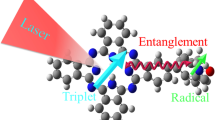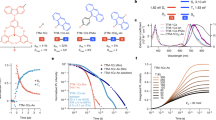Abstract
The interconversion between singlet and triplet spin states of photogenerated radical pairs is a genuine quantum process, which can be harnessed to coherently manipulate the recombination products through a magnetic field. This control is central to such diverse fields as molecular optoelectronics, quantum sensing, quantum biology and spin chemistry, but its effect is typically fairly weak in pure molecular systems. Here we introduce hybrid radical pairs constructed from semiconductor quantum dots and organic molecules. The large g-factor difference enables us to directly observe the radical-pair spin quantum beats usually hidden in previous studies, which are further accelerated by the strong exchange coupling of radical pairs enabled by the quantum confinement of quantum dots. The rapid quantum beats enable the efficient and coherent control of charge recombination dynamics at room temperature, with the modulation level of the yield of spin-triplet products reaching 400%.
This is a preview of subscription content, access via your institution
Access options
Access Nature and 54 other Nature Portfolio journals
Get Nature+, our best-value online-access subscription
27,99 € / 30 days
cancel any time
Subscribe to this journal
Receive 12 print issues and online access
269,00 € per year
only 22,42 € per issue
Buy this article
- Purchase on SpringerLink
- Instant access to full article PDF
Prices may be subject to local taxes which are calculated during checkout





Similar content being viewed by others
Data availability
All data are available in the Article or its Supplementary Information, and are available from the corresponding author upon request. They are also available via figshare at https://doi.org/10.6084/m9.figshare.27262569. Source data are provided with this paper.
Code availability
The codes developed for this study are available from the corresponding author upon request.
References
Rao, A. et al. The role of spin in the kinetic control of recombination in organic photovoltaics. Nature 500, 435–439 (2013).
Goushi, K., Yoshida, K., Sato, K. & Adachi, C. Organic light-emitting diodes employing efficient reverse intersystem crossing for triplet-to-singlet state conversion. Nat. Photon. 6, 253–258 (2012).
Kuehne, A. J. C. & Gather, M. C. Organic lasers: recent developments on materials, device geometries, and fabrication techniques. Chem. Rev. 116, 12823–12864 (2016).
Qin, C. et al. Stable room-temperature continuous-wave lasing in quasi-2D perovskite films. Nature 585, 53–57 (2020).
Smith, M. B. & Michl, J. Singlet fission. Chem. Rev. 110, 6891–6936 (2010).
Luo, X. et al. Mechanisms of triplet energy transfer across the inorganic nanocrystal/organic molecule interface. Nat. Commun. 11, 28 (2020).
Hou, Y. et al. Charge separation, charge recombination, long-lived charge transfer state formation and intersystem crossing in organic electron donor/acceptor dyads. J. Mater. Chem. C 7, 12048–12074 (2019).
Harvey, S. M. & Wasielewski, M. R. Photogenerated spin-correlated radical pairs: from photosynthetic energy transduction to quantum information science. J. Am. Chem. Soc. 143, 15508–15529 (2021).
Wigner, E. & Witmer, E. E. Über die Struktur der zweiatomigen Molekelspektren nach der Quantenmechanik. Z. Phys. 51, 859–886 (1928).
Brocklehurst, B. Magnetic fields and radical reactions: recent developments and their role in nature. Chem. Soc. Rev. 31, 301–311 (2002).
Steiner, U. E. & Ulrich, T. Magnetic field effects in chemical kinetics and related phenomena. Chem. Rev. 89, 51–147 (1989).
Lambert, N. et al. Quantum biology. Nat. Phys. 9, 10–18 (2013).
Ritz, T., Thalau, P., Phillips, J. B., Wiltschko, R. & Wiltschko, W. Resonance effects indicate a radical-pair mechanism for avian magnetic compass. Nature 429, 177–180 (2004).
Xu, J. et al. Magnetic sensitivity of cryptochrome 4 from a migratory songbird. Nature 594, 535–540 (2021).
Gilch, P., Pöllinger-Dammer, F., Musewald, C., Michel-Beyerle, M. E. & Steiner, U. E. Magnetic field effect on picosecond electron transfer. Science 281, 982–984 (1998).
Klein, J. H., Schmidt, D., Steiner, U. E. & Lambert, C. Complete monitoring of coherent and incoherent spin flip domains in the recombination of charge-separated states of donor-iridium complex-acceptor triads. J. Am. Chem. Soc. 137, 11011–11021 (2015).
Kim, T. et al. Magnetic-field-induced modulation of charge-recombination dynamics in a rosarin-fullerene complex. Angew. Chem. Int. Ed. 60, 9379–9383 (2021).
Mims, D., Herpich, J., Lukzen, N. N., Steiner, U. E. & Lambert, C. Readout of spin quantum beats in a charge-separated radical pair by pump-push spectroscopy. Science 374, 1470–1474 (2021).
Feskov, S. V. et al. Magnetic field effect on ion pair dynamics upon bimolecular photoinduced electron transfer in solution. J. Chem. Phys. 150, 024501 (2019).
Devir-Wolfman, A. H. et al. Short-lived charge-transfer excitons in organic photovoltaic cells studied by high-field magneto-photocurrent. Nat. Commun. 5, 4529 (2014).
García de Arquer, F. P. et al. Semiconductor quantum dots: technological progress and future challenges. Science 373, eaaz8541 (2021).
Brus, L. E. A simple model for the ionization potential, electron affinity, and aqueous redox potentials of small semiconductor crystallites. J. Chem. Phys. 79, 5566–5571 (1983).
Zhu, H., Yang, Y., Wu, K. & Lian, T. Charge transfer dynamics from photoexcited semiconductor quantum dots. Annu. Rev. Phys. Chem. 67, 259–281 (2016).
Harris, R. D. et al. Electronic processes within quantum dot-molecule complexes. Chem. Rev. 116, 12865–12919 (2016).
Mongin, C., Garakyaraghi, S., Razgoniaeva, N., Zamkov, M. & Castellano, F. N. Direct observation of triplet energy transfer from semiconductor nanocrystals. Science 351, 369–372 (2016).
Xia, P. et al. Achieving spin-triplet exciton transfer between silicon and molecular acceptors for photon upconversion. Nat. Chem. 12, 137–144 (2020).
Lu, H., Chen, X., Anthony, J. E., Johnson, J. & Beard, M. C. Sensitizing singlet fission with perovskite nanocrystals. J. Am. Chem. Soc. 141, 4919–4927 (2019).
Wu, M. et al. Solid-state infrared-to-visible upconversion sensitized by colloidal nanocrystals. Nat. Photon. 10, 31–34 (2016).
Thompson, N. J. et al. Energy harvesting of non-emissive triplet excitons in tetracene by emissive PbS nanocrystals. Nat. Mater. 13, 1039–1043 (2014).
Tabachnyk, M. et al. Resonant energy transfer of triplet excitons from pentacene to PbSe nanocrystals. Nat. Mater. 13, 1033–1038 (2014).
Gholizadeh, E. M. et al. Photochemical upconversion of near-infrared light from below the silicon bandgap. Nat. Photon. 14, 585–590 (2020).
Wen, S. et al. Future and challenges for hybrid upconversion nanosystems. Nat. Photon. 13, 828–838 (2019).
Wang, J. et al. Spin-controlled charge recombination pathways across the inorganic/organic interface. J. Am. Chem. Soc. 142, 4723–4731 (2020).
Weinberg, D. J. et al. Spin-selective charge recombination in complexes of CdS quantum dots and organic hole acceptors. J. Am. Chem. Soc. 136, 14513–14518 (2014).
Jin, T. et al. Enhanced triplet state generation through radical pair intermediates in BODIPY-quantum dot complexes. J. Chem. Phys. 151, 241101 (2019).
Lee, A. Y. et al. Quantum dot–organic molecule conjugates as hosts for photogenerated spin qubit pairs. J. Am. Chem. Soc. 145, 4372–4377 (2023).
Olshansky, J. H. et al. Using photoexcited core/shell quantum dots to spin polarize appended radical qubits. J. Am. Chem. Soc. 142, 13590–13597 (2020).
Liu, M. et al. Spin-enabled photochemistry using nanocrystal-molecule hybrids. Chem 8, 1720–1733 (2022).
Gupta, J. A., Awschalom, D. D., Efros, A. L. & Rodina, A. V. Spin dynamics in semiconductor nanocrystals. Phys. Rev. B 66, 125307 (2002).
Zhang, Y. et al. Hyperfine-induced electron-spin dephasing in negatively charged colloidal quantum dots: a survey of size dependence. J. Phys. Chem. Lett. 12, 9481–9487 (2021).
Luo, X. et al. Triplet energy transfer from CsPbBr3 nanocrystals enabled by quantum confinement. J. Am. Chem. Soc. 141, 4186–4190 (2019).
Pu, C. et al. Highly reactive, flexible yet green Se precursor for metal selenide nanocrystals: Se-octadecene suspension (Se-SUS). Nano Res. 6, 652–670 (2013).
Wang, J. et al. Marcus inverted region of charge transfer from low-dimensional semiconductor materials. Nat. Commun. 12, 6333 (2021).
Dworak, L., Roth, S. & Wachtveitl, J. Charge transfer-induced state filling in CdSe quantum dot–alizarin complexes. J. Phys. Chem. C 121, 2613–2619 (2017).
Feng, D. et al. Dynamic evolution from negative to positive photocharging in colloidal CdS quantum dots. Nano Lett. 17, 2844–2851 (2017).
Machatová, Z. et al. Study of natural anthraquinone colorants by EPR and UV/vis spectroscopy. Dyes Pigm. 132, 79–93 (2016).
Wang, J., Ding, T. & Wu, K. Charge transfer from n-doped nanocrystals: mimicking intermediate events in multielectron photocatalysis. J. Am. Chem. Soc. 140, 7791–7794 (2018).
Riese, S. et al. Giant magnetic field effects in donor–acceptor triads: on the charge separation and recombination dynamics in triarylamine–naphthalenediimide triads with bis-diyprrinato-palladium(ii), porphodimethenato-palladium(ii), and palladium(ii)–porphyrin photosensitizers. J. Chem. Phys. 153, 054306 (2020).
Weiss, E. A. et al. Making a molecular wire: charge and spin transport through para-phenylene oligomers. J. Am. Chem. Soc. 126, 5577–5584 (2004).
Shornikova, E. V. et al. Surface spin magnetism controls the polarized exciton emission from CdSe nanoplatelets. Nat. Nanotechnol. 15, 277–282 (2020).
Dyakonov, M. I. & Khaetskii, A. Spin Physics in Semiconductors Vol. 157 (Springer, 2008).
Zhu, H. et al. Auger-assisted electron transfer from photoexcited semiconductor quantum dots. Nano Lett. 14, 1263–1269 (2014).
Lambert, C. & Redmond, R. W. Triplet energy level of β-carotene. Chem. Phys. Lett. 228, 495–498 (1994).
Dugave, C. & Demange, L. Cis−trans isomerization of organic molecules and biomolecules: Implications and applications. Chem. Rev. 103, 2475–2532 (2003).
Rodriguez-Amaya, D. B. Food Carotenoids: Chemistry, Biology and Technology (John Wiley & Sons, 2015).
Yu, W. W. & Peng, X. G. Formation of high-quality CdS and other II-VI semiconductor nanocrystals in noncoordinating solvents: tunable reactivity of monomers. Angew. Chem. Int. Ed. 41, 2368–2371 (2002).
Acknowledgements
K.W. acknowledges financial support from the National Natural Science Foundation of China (grant no. 22173098), the Chinese Academy of Sciences (grant nos. XDB0970303 and YSBR-007), Dalian Institute of Chemical Physics (grant no. DICP I202106) and the Fundamental Research Funds for the Central Universities (grant no. 20720220009). K.W. also acknowledges the New Cornerstone Science Foundation through the XPLORER PRIZE. M.L. acknowledges Y. Lv and J. Du for the transmission electron microscopy measurements of QDs.
Author information
Authors and Affiliations
Contributions
K.W. initiated the idea and supervised the project. M.L. synthesized the samples and performed the spectroscopy with the help of J.Z. M.L. and J.Z. performed the simulations. G.Z., Y.L., Y.Y. and K.G. participated in the spectroscopy experiments. K.W. and M.L. wrote the manuscript with inputs from all authors.
Corresponding author
Ethics declarations
Competing interests
The authors declare no competing interests.
Peer review
Peer review information
Nature Materials thanks Ulrich Steiner and the other, anonymous, reviewer(s) for their contribution to the peer review of this work.
Additional information
Publisher’s note Springer Nature remains neutral with regard to jurisdictional claims in published maps and institutional affiliations.
Supplementary information
Supplementary Information
Supplementary Notes 1–5, Figs. 1–24, Tables 1–7, Equations (1)–(14) and References.
Source data
Source Data Fig. 1
Source data for Fig. 1.
Source Data Fig. 2
Source data for Fig. 2.
Source Data Fig. 3
Source data for Fig. 3.
Source Data Fig. 4
Source data for Fig. 4.
Source Data Fig. 5
Source data for Fig. 5.
Rights and permissions
Springer Nature or its licensor (e.g. a society or other partner) holds exclusive rights to this article under a publishing agreement with the author(s) or other rightsholder(s); author self-archiving of the accepted manuscript version of this article is solely governed by the terms of such publishing agreement and applicable law.
About this article
Cite this article
Liu, M., Zhu, J., Zhao, G. et al. Coherent manipulation of photochemical spin-triplet formation in quantum dot–molecule hybrids. Nat. Mater. 24, 260–267 (2025). https://doi.org/10.1038/s41563-024-02061-1
Received:
Accepted:
Published:
Issue Date:
DOI: https://doi.org/10.1038/s41563-024-02061-1
This article is cited by
-
Spin control of hybrid quantum-dot-based radical pairs
Nature Materials (2025)



